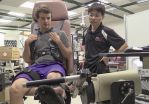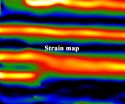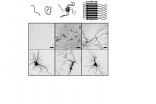FDG-PET/CT shows promise for breast cancer patients younger than 40
Molecular imaging upstaged diagnosis in 21 percent of patients
2014-10-01
(Press-News.org) Reston, Va. (October 1, 2014) – Researchers at Memorial Sloan Kettering found that PET/CT imaging of patients younger than 40 who were initially diagnosed with stage I–III breast cancer resulted in change of diagnosis. As reported in the October issue of The Journal of Nuclear Medicine, while guidelines recommend FDG-PET/CT imaging only for women with stage III breast cancer, it can also help physicians more accurately diagnose young breast cancer patients initially diagnosed with earlier stages of the disease.
Assessing if and how far breast cancer has spread throughout the body is what doctor's refer to as staging. Most women nowadays are diagnosed at earlier stages, meaning stage 1 or 2 of possible 4 stages (stated Christopher Riedl, MD). Current National Comprehensive Cancer Network (NCCN) guidelines consider systemic FDG-PET/CT staging for only stage III breast cancer patients. More recently it has been debated whether factors other than stage should be considered in this decision. One such factor is patient age, as young breast cancer patients often have more aggressive tumors. In this study, a team of researchers from Memorial Sloan Kettering Cancer Center in New York evaluated for the first time the impact of FDG PET/CT staging specifically in a young patient cohort. The study suggests that breast cancer patients under the age of 40 may benefit from systemic staging with FDG PET/CT at earlier stages than NCCN guidelines suggest.
"Proper staging right after the breast cancer has first been diagnosed will help doctors make the right treatment decisions. And figuring out which breast cancer patients will benefit most from this 'advanced staging' with FDG PET/CT helps us to improve patient care while avoiding unnecessary tests," stated Christopher Riedl, MD, one of the team's lead researchers. "Our data suggest that women younger than 40 may benefit from PET/CT staging at earlier stages than doctors previously believed."
The study included 134 patients with initial diagnoses of stage I to IIIC breast cancer; those with signs of distant metastases or with prior malignancy were excluded. PET/CT findings lead to upstaging to stage III or IV in 28 patients (21%). Unsuspected extra-axillary regional nodes were found in 15/134 (11%) and distant metastases in 20/134 (15%), with 7/134 (5%) demonstrating both. PET/CT revealed stage IV disease in 1/20 (5%) patients with initial clinical stage I, 2/44 (5 %) stage IIA, 8 /47 (17 %) stage IIB, 4/13 (31%) stage IIIA, 4/8 (50%) of IIIB, and 1/2 (50%) of stage IIIC patients. All 20 patients upstaged to stage IV were histologically confirmed. Four synchronous thyroid and 1 rectal malignancies were identified.
"Future NCCN guidelines for initial staging of breast cancer patients may need to consider other factors in addition to clinical stage. This study provides further evidence that molecular imaging and nuclear medicine can help us make better cancer staging and treatment decisions," said Gary Ulaner, MD, PhD, assistant professor at Memorial Sloan Kettering. "Of course, our findings should still be confirmed in a prospective trial," he added. "Our next step will be to look at factors other than patient age to understand which breast cancer patients benefit most from FDG-PET/CT."
INFORMATION:
Authors of the article "Retrospective analysis of FDG PET/CT for staging asymptomatic breast cancer patients below 40 years of age" include Christopher C Riedl, Elina Slobod, Maxine Jochelson, Monica Morrow, Debra A. Goldman, Mithat Gonen, Wolfgang Andreas Weber, and Gary A Ulaner, Memorial Sloan Kettering Cancer Center, New York.
Please visit the SNMMI Media Center to view the PDF of the study, including images, and more information about molecular imaging and personalized medicine. To schedule an interview with the researchers, please contact Kimberly Brown. Current and past issues of The Journal of Nuclear Medicine can be found online at http://jnm.snmjournals.org.
About the Society of Nuclear Medicine and Molecular Imaging
The Society of Nuclear Medicine and Molecular Imaging (SNMMI) is an international scientific and medical organization dedicated to raising public awareness about nuclear medicine and molecular imaging, a vital element of today's medical practice that adds an additional dimension to diagnosis, changing the way common and devastating diseases are understood and treated and helping provide patients with the best health care possible.
SNMMI's more than 18,000 members set the standard for molecular imaging and nuclear medicine practice by creating guidelines, sharing information through journals and meetings and leading advocacy on key issues that affect molecular imaging and therapy research and practice. For more information, visit http://www.snmmi.org.
ELSE PRESS RELEASES FROM THIS DATE:
2014-10-01
As the threat of antibiotic resistance grows, scientists are turning to the human body and the trillion or so bacteria that have colonized us — collectively called our microbiota — for new clues to fighting microbial infections. They've logged an early success with the discovery of a new antibiotic candidate from vaginal bacteria, reports Chemical & Engineering News (C&EN), the weekly newsmagazine of the American Chemical Society.
Matt Davenport, a C&EN contributing editor, explains that the human microbiota produces thousands of small molecules. Some have been discovered ...
2014-10-01
Here's another reason why it's a good idea to hit the gym: it can improve memory. A new Georgia Institute of Technology study shows that an intense workout of as little as 20 minutes can enhance episodic memory, also known as long-term memory for previous events, by about 10 percent in healthy young adults (see a video demo).
The Georgia Tech research isn't the first to find that exercise can improve memory. But the study, which was just published in the journal Acta Psychologica, took a few new approaches. While many existing studies have demonstrated that months of ...
2014-10-01
Materials – Vehicle Lightweighting ...
For about the price of leather seats, automakers can trim approximately 362 pounds off the body and chassis of a midsize passenger vehicle, according to an Oak Ridge National Laboratory study. Researchers analyzed an array of materials – carbon fiber, advanced high-strength steel, aluminum alloys, magnesium alloys – that could replace steel. While the carbon fiber composite option reduced weight by 35 percent at an additional cost of $1,317, a combination of advanced high-strength steel and alloys resulted in a 25 percent weight ...
2014-10-01
Pity the poor lithium ion. Drawn relentlessly by its electrical charge, it surges from anode to cathode and back again, shouldering its way through an elaborate molecular obstacle course. This journey is essential to powering everything from cell phones to cordless power tools. Yet, no one really understands what goes on at the atomic scale as lithium ion batteries are used and recharged, over and over again.
Michigan Technological University researcher Reza Shahbazian-Yassar has made it his business to better map the ion's long, strange trip—and perhaps make it smoother ...
2014-10-01
People who are unable to button up their jacket or who find it difficult to insert a key in lock suffer from a condition known as apraxia. This means that their motor skills have been impaired – as a result of a stroke, for instance. Scientists in Munich have now examined the parts of the brain that are responsible for planning and executing complex actions. They discovered that there is a specific network in the brain for using tools. Their findings have been published in the Journal of Neuroscience.
Researchers from Technische Universität München (TUM) and the Klinikum ...
2014-10-01
Researchers have discovered a new type of brain activity that underlies the timing of voluntary actions, allowing them to forecast when a spontaneous decision will occur more than a second in advance. 'Experiments like this have been used to argue that free will is an illusion, but we think that this interpretation is mistaken,' says Zachary Mainen, a neuroscientist at the Champalimaud Centre for the Unknown, in Lisbon, Portugal, who led the research, published on Sept. 28, 2014, in the journal Nature Neuroscience.
The scientists used recordings of neurons in an area ...
2014-10-01
The peptide —a small protein— beta-amyloid is strongly associated with Alzheimer's disease; however, researchers are still looking for unequivocal proof that this peptide is the causal agent of the onset and development of the disease. The main obstacle impeding such confirmation is that beta-amyloid is not harmful when found in isolation but only when it aggregates, that is when it self-assembles to form the so-called amyloid fibrils
"We are not dealing with a single target, beta-amyloid alone, but with multiple ones because each aggregate of peptide, which can go from ...
2014-10-01
Current changes in the ocean around Antarctica are disturbingly close to conditions 14,000 years ago that new research shows may have led to the rapid melting of Antarctic ice and an abrupt 3-4 metre rise in global sea level.
The research published in Nature Communications found that in the past, when ocean temperatures around Antarctica became more layered - with a warm layer of water below a cold surface layer - ice sheets and glaciers melted much faster than when the cool and warm layers mixed more easily.
This defined layering of temperatures is exactly what is ...
2014-10-01
An international team of scientists has shown that more than 80 per cent of bowel cancers could be treated with existing drugs.
The study found that medicines called 'JAK inhibitors' halted tumour growth in bowel cancers with a genetic mutation that is present in more than 80 per cent of bowel cancers. Multiple JAK inhibitors are currently used, or are in clinical trials, for diseases including rheumatoid arthritis, psoriasis, blood cancers and myeloproliferative disorders.
Bowel cancer is the second-most common cancer in Australia with nearly 17,000 people diagnosed ...
2014-10-01
DURHAM, N.C. -- A Duke University team has found that nanoparticles called single-walled carbon nanotubes accumulate quickly in the bottom sediments of an experimental wetland setting, an action they say could indirectly damage the aquatic food chain.
The results indicate little risk to humans ingesting the particles through drinking water, say scientists at Duke's Center for the Environmental Implications of Nanotechnology (CEINT). But the researchers warn that, based on their previous research, the tendency for the nanotubes to accumulate in sediment could indirectly ...
LAST 30 PRESS RELEASES:
[Press-News.org] FDG-PET/CT shows promise for breast cancer patients younger than 40
Molecular imaging upstaged diagnosis in 21 percent of patients





